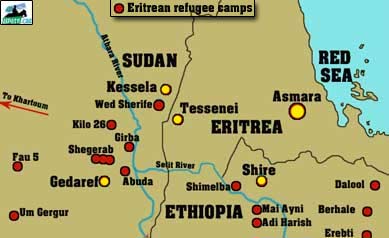Italy-Bound, 15 Eritreans Die in the Mediterranean

Earlier last month, at least 15 Eritreans, heading from Libya to Italy, were killed when their boat encountered a storm in the Mediterranean Sea.
Most died while attempting to transfer from their small boat to a Maltese ship that was dispatched to rescue them.
The identity of those killed is not known, but most are believed to be Eritrean males in their 20s.
In addition to the Eritreans, the boat also carried East Africans of unknown origin.
Background
Thousands of Eritreans of conscription age have left their country by crossing the borders of Ethiopia, Sudan or the Red Sea.
Those who fled to Ethiopia were held in the make-shift camps of Wa’ela Nihbi but were moved, at the insistence and expense of UNHCR, to more permanent refugee settlements at Shimaleba. There are nearly 10,000 Eritrean refugees at Shimaleba and the UNHCR estimates an inflow of 250 per month. The UNHCR has began processing the asylum application of some of the refugees and some have already arrived in the US, Canada, New Zealand, Australia and South Africa.
The Sudan has been the home of hundreds of thousands of Eritreans, some of whom have resided in refugee camps of Eastern Sudan(wedelhilew, wed sheriff, Showak, Um Gargur) since the 1960s. Others have been integrated into the Sudanese community. In 2000, when the UNHCR included Eritrea in its pilot program of the so-called 4Rs (Repatriation, Reintegration, Rehabilitation and Reconstruction), over 100,000 Eritreans were returned and the UNHCR declared its project a victory and issued a report in 2003 stating that the conditions that forced Eritreans to leave their country no longer exist and Eritreans are not eligible for refugee status in Sudan. UNHCR’s early declaration has been belied by the surge of immigration to Sudan, where hundreds arrive every month and it is reconsidering its decision based on the appeal of refugee rights activists like Suwera.
Some of the Eritreans who migrate to Sudan eventually move to Kenya or to Libya, mostly by walking, and fewer still manage to cross the Mediterranean and seek asylum in Italy. Others are apprehended and returned to Eritrea where they now work in forced labor camps. In August 2004, in an effort, to avoid this fate, 15 Eritreans hijacked a plane bound from Libya to Eritrea and forced it to land in Sudan.
The Eritrean government has upped the ante by imposing fines on the parents of the youth who escape. Consequently, those who do manage to escape are unwilling to have their identities publicized.



Awate Forum